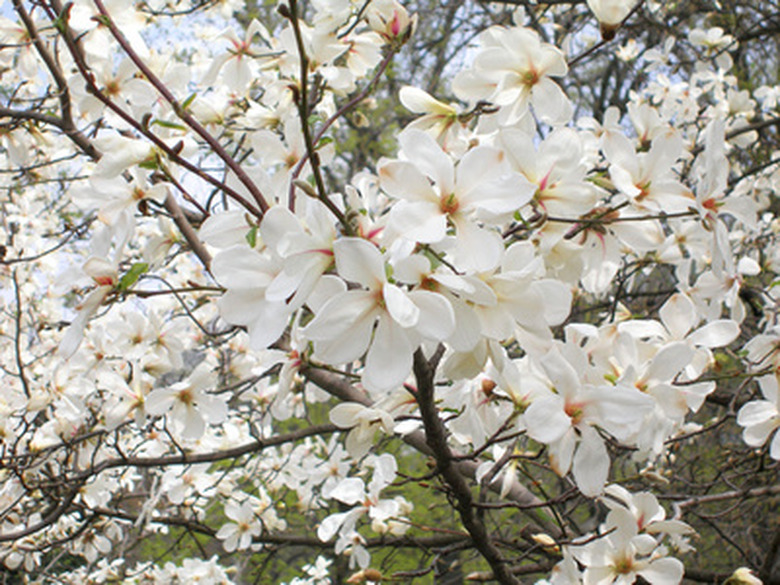Different Varieties Of A Magnolia Tree
Magnolia trees belong to the Magnoliaceae plant family and typically prefer moist, rich soils in partly to fully sunny locations. If you would like to plant magnolia trees, select varieties according to your U.S. Department of Agriculture (USDA) hardiness zone, the intended use, the tree's bloom time and its flower color. Many magnolia varieties perform well in U.S. landscapes.
Swamp Magnolia
Swamp magnolia trees (Magnolia virginiana var. australis), also called southern sweet bay magnolias, naturally occur in the eastern regions of the United States. Mature trees range from 10 to 60 feet in height with similar spreads. Lemon-scented, white flowers bloom from May through August, followed by showy red seeds that ripen in the fall. The glossy, green leaves feature silver-green undersides. Winter hardy in USDA zones 5 to 10, this magnolia species can tolerate boggy soil conditions. Gardeners often use swamp magnolia trees in foundation plantings, woodland margins, parks and stream margins.
- Magnolia trees belong to the Magnoliaceae plant family and typically prefer moist, rich soils in partly to fully sunny locations.
- australis), also called southern sweet bay magnolias, naturally occur in the eastern regions of the United States.
Star Magnolia
The star magnolia (Magnolia stellata) reaches up to 20 feet in height with slightly smaller spreads. This Japanese native tree performs well in USDA zones 4 to 8. Fragrant, star-shaped, white blossoms appear in March, giving way to green pods that contain reddish seeds. The deep-green leaves turn non-showy, yellow-brown shades in autumn. Star magnolias prefer planting locations that protect them from high winds. Star magnolia trees generally work well as informal hedges, specimen trees and foundation plants.
Kobus Magnolia
The kobus magnolia tree (Magnolia kobus) naturally occurs in Japanese forests and generally grows well in USDA zones 5 to 8. This magnolia variety ranges from 25 to 30 feet in height with similar spreads. Flowers display in March and April, featuring fragrant white petals with slight pink tints. Kobus magnolias sometimes take as long as 25 years to produce flowers. This tree also bears reddish seeds that attract birds and deep-green leaves that turn inconspicuous yellowish-brown shades in the autumn. Frosts often damage this early bloomer. Gardeners primarily plant kobus magnolia trees in shrub borders, woodland margins and foundation plantings.
- The star magnolia (Magnolia stellata) reaches up to 20 feet in height with slightly smaller spreads.
Saucer Magnolia
Saucer magnolia trees (Magnolia x soulangeana) bloom in March, featuring fragrant white flowers flushed with bright pink or purple shades. Some trees take up to five years before producing their first buds. This magnolia species is of garden origin and typically does well in USDA zones 4 to 9. Mature trees range from 20 to 25 feet in both height and width. The saucer magnolia performs well as a lawn specimen tree.
Large-Flowered Magnolia
The large-flowered magnolia tree (Magnolia grandiflora) naturally occurs in the southern part of the United States and typically performs well in USDA zones 7 to 9. This magnolia variety reaches between 60 and 80 feet in height and 30 to 50 feet in width. Large, scented white flowers appear in May and June, followed by pink or red fruit clusters. The deep-green leaves have light-green undersides. Southern gardeners often use the large-flowered magnolia as a specimen tree for larger lawns or park areas.
- Saucer magnolia trees (Magnolia x soulangeana) bloom in March, featuring fragrant white flowers flushed with bright pink or purple shades.
